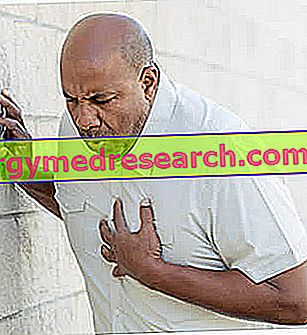Generality
Disc protrusion is a type of discopathy; its presence is characterized by a deformation of the outermost layer of an intervertebral disk of the column, such that the latter is crushed and out of axis with respect to the other healthy intervertebral discs.

The typical symptoms of disc protrusion are: pain in a specific section of the spine, pain, tingling and numbness along the lower or upper limbs, and muscle weakness.
For a correct diagnosis, physical examination, history, magnetic resonance (and / or CT), neurological evaluation and electromyography are essential.
Treatment of disc protrusion depends on the severity of the condition. In fact, for less severe cases, conservative therapy is generally sufficient; for the more serious cases and that do not respond to conservative treatment, surgical treatment is instead necessary.
Brief anatomical revision of the vertebral column and vertebrae
Supporting axis of the human body, the vertebral column or spine is a bone structure of about 70 centimeters (in the adult human being), which includes 33-34 irregular bones, stacked on each other and known as vertebrae .
The basic structure of a generic vertebra of the spine includes:
- A body, in anterior position;
- A bow similar to a horseshoe, in a rear position. It is the so-called vertebral arch, in which two peduncles can be distinguished, two transverse processes, two superior articular processes, two inferior articular processes, a spinous process and two laminae;
- Finally, a vertebral hole, deriving from the particular arrangement of the arch with respect to the body. The set of vertebral holes of all the vertebrae constitutes the so-called spinal canal . The spinal cord is housed in the vertebral canal.

Between one vertebra and another, there is a disk of fibrocartilaginous tissue, called intervertebral disc, whose function is to absorb shocks and loads to the damage of the spine. In other words, the intervertebral discs act as small shock absorber bearings.
Inside the intervertebral disc take place the so-called nucleus pulposus and the cartilaginous coating of the latter, the so-called fibrous ring .

What is disc protrusion?
Disc protrusion is a medical condition of the spine, characterized by the deformation of the outermost layer of an intervertebral disc, such that the latter is crushed and out of axis with respect to the other healthy intervertebral discs.
Disc protrusion is included in the list of discopathies - ie diseases of the intervertebral disc - and represents, in many cases, the prelude to a herniated disc .
With the term "herniated disc", doctors indicate the leakage, from its natural site, of the pulpous nucleus contained within the intervertebral disc.
WHERE CAN YOU HAVE LOCATION?
Disc protrusion episodes may be located along the cervical, thoracic or lumbar spine sections.
The disc protrusion concerning an intervertebral disc of the cervical spine of the column is called cervical disc protrusion ; the disc protrusion involving a thoracic intervertebral disc is called thoracic disc protrusion ; finally, the disc protrusion on a lumbar intervertebral disc assumes the wording of lumbar disc protrusion .
Most cases of disc protrusion are cervical or lumbar.
Causes
The intervertebral discs of a young or middle-aged adult are 90% water. This water guarantees elasticity to the intervertebral discs, resistance to deformation and cushioning capacity.
With advancing age and the consequent aging of the human body, the intervertebral discs are victims of a progressive degeneration, which involves the irreversible loss of a large part of their water component.
The loss of water by the intervertebral discs makes the latter more fragile, less elastic, prone to deformation and prone to breakage.
Disc protrusion is a typical consequence of the changes that the aging of the human body causes to damage the intervertebral discs.
OTHER CAUSES
In addition to aging, which is the main cause of disc protrusion, other triggering or favoring factors are:
- Wrong habits and lifestyles . Cigarette smoking, obesity, a sedentary lifestyle, excessive physical activity, a tendency to take wrong postures and an incorrect diet are associated with discal protrusion. According to some research, these conditions would lead to a weakening of the intervertebral discs.
- Spine trauma . The vertebral traumas following violent falls, falls from great heights, road accidents and sports injuries are closely connected to the disc protrusion.
- Repeated lifting with the wrong modalities of very heavy objects .
- Excessive weakening or thinning of the muscles and / or ligaments of the back .
Symptoms, signs and complications
From the spinal cord, contained in the spinal canal of the vertebral column, the so-called spinal nerves are born. As they escape from the spinal cord, these nerves pass into the immediate vicinity of the intervertebral discs, without coming into direct contact with them.
The proximity between the intervertebral discs and the spinal nerves means that, when the former undergo an obvious deformation, they compress the latter, causing the phenomenon known as nerve compression .
Disc protrusin may be symptomatic or asymptomatic: if the intervertebral disc affected by the deformation compresses the nearby spinal nerves, the condition is symptomatic; if instead, despite the deformation, the intervertebral disc does not compress the spinal nerves passing nearby, the condition is asymptomatic.
TYPICAL MANIFESTATIONS
The most common symptoms and signs of disc protrusion are:
- Local chronic pain, located where the deformed intervertebral disc resides and where the nerve branches of the spinal nerves reach under compression;
- Sense of numbness and / or stiffness in the lower limbs or in the upper part of the body (arms, hands, neck, head, etc.);
- Tingling in the lower limbs or in the upper body (arms, hands, neck, head, etc.);
- Muscle weakness where nerve branches of compressed spinal nerves arrive;
- Sciatica, or inflammation of the sciatic nerve. It takes place when the disc protrusion concerns the spinal roots of the sciatic nerve;
- Radiant pain .
CERVICAL DISCUSSION: THE CHARACTERISTIC SYMPTOMS
Episodes of cervical disc protrusion are characterized by a compression of the spinal nerves of the cervical tract.
Their typical symptoms are: pain in the neck ( neck pain), pain in the shoulders, arms and / or hands, headache, numbness in the face, arms and / or hands, and weakness in the shoulder muscles, elbows, wrists and / or hands.
LUMBAR DISC PROTRUSION: THE CHARACTERISTIC SYMPTOMS
The episodes of lumbar disc protrusion are characterized by a compression of the spinal nerves of the lumbar tract.
Their typical manifestations consist of: pain in the lumbar area of the back ( lumbago ), pain in the buttocks, groin, thighs and / or legs, numbness in the lower limbs, tingling in the lower limbs and weakness of the muscles they control the movement of the feet.
Diagnosis
In general, to correctly diagnose a disc protrusion, the following are fundamental:
- A thorough physical examination and a careful medical history . They are useful for the doctor to understand what the symptoms are, why and when the condition has arisen, what features it presents and how severe it is, etc .;
- A neurological evaluation . Helps establish the health of the spinal nerves, the probable site of nerve compression, the severity of the disc protrusion, etc .;
- Images provided by examinations such as nuclear magnetic resonance ( NMR ) of the spine or CT ( Computerized Axial Tomography ) of the spine. MRI and CT are painless, but, while the former does not expose the patient to any harmful radiation (only magnetic fields that are harmless to health), the latter involves exposing the patient to a non-negligible dose of ionizing radiation harmful to being human.
- Electromyography . It involves the study of the conduction of nerve signals along the manifesting area of the symptoms and, subsequently, the evaluation of the electrical activity of the muscle (s), always located in the symptomatic zone.
Accurate diagnosis of disc protrusion plays a key role in planning the most appropriate treatment.
Therapy
Treatment of disc protrusion depends mainly on the severity of the condition. In fact, for the less severe cases of disc protrusion, a conservative therapy ( conservative treatment ) is sufficient; while for the most serious cases it is essential to resort to a surgical therapy ( surgical treatment ).
CONSERVATIVE TREATMENT
The conservative treatment adopted in the case of disc protrusion usually includes:
- Pharmacological treatment . Among the indicated medicines, include painkillers, muscle relaxants, non-steroidal anti-inflammatory drugs (NSAIDs) and corticosteroids (the latter only when NSAIDs prove ineffective);
- Physiotherapy . The physiotherapy treatment consists of strengthening exercises of the back muscles, stretching exercises of the back muscles, exercises to increase the flexibility of the spine, etc .;
- Massage therapy . It is a practice recommended to reduce pain.
If the patient follows him with care, a good conservative treatment for the disc protrusion has clear benefits, from the symptomatic point of view, after 6 weeks that has begun.
SURGICAL TREATMENT
The surgical treatment of disc protrusion consists of a discectomy . Discectomy is a surgical operation that involves the removal of the damaged or no longer functional intervertebral disc, and the replacement of the latter with a sort of prosthesis.
From a procedural point of view, discectomy is a complex and very delicate procedure, which requires a surgical incision in anatomical areas presenting a dense network of nerves, ligaments and blood vessels.
The delicacy of the discectomy intervention is the reason why the doctors practice it in severe cases or when conservative remedies are completely ineffective.
Prognosis
The severity of the condition has a decisive influence on the prognosis of disc protrusion. In general, in fact, the more severe a disc protrusion is, the less the chances of success of the therapy.
Prevention
At present, there is no remedy to prevent disc protrusion, with a probability close to or equal to 100%.
However, there are various precautionary measures that greatly reduce the risk:
- Use your body properly, while lifting weights, and avoid excessive back torsions. There are numerous online guides that teach how to lift a weight without burdening the spine.
- Maintain a correct posture, especially in a sitting position, so as not to alter the normal anatomy of the spine.
- Exercise regularly, because, as you remember, inactivity is a predisposing factor for the disc protrusion.



